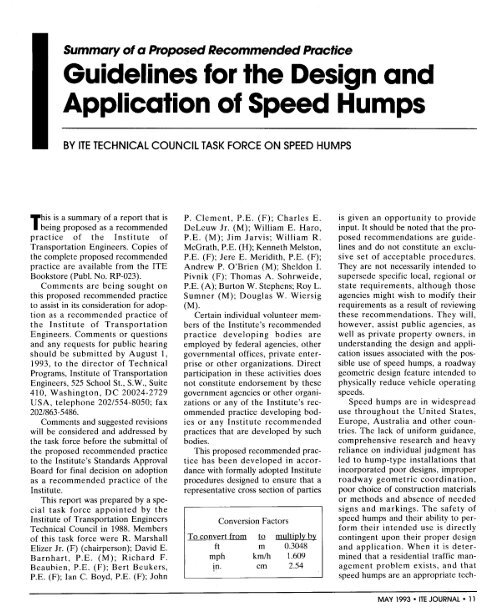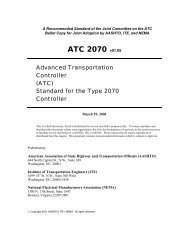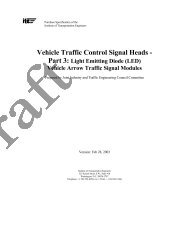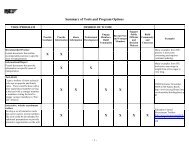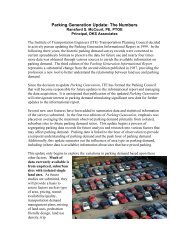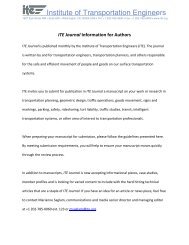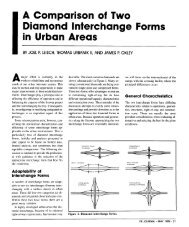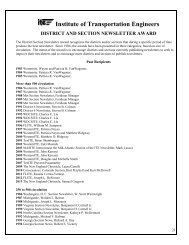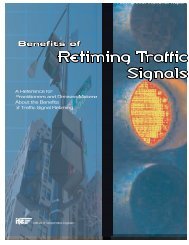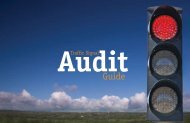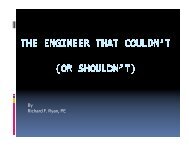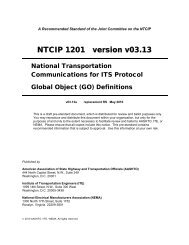Guidelines for the Design and Application ofSpeed Humps
Guidelines for the Design and Application ofSpeed Humps
Guidelines for the Design and Application ofSpeed Humps
Create successful ePaper yourself
Turn your PDF publications into a flip-book with our unique Google optimized e-Paper software.
ISummary of a Proposed Recommended Practjce<br />
<strong>Guidelines</strong> <strong>for</strong> <strong>the</strong> <strong>Design</strong> <strong>and</strong><br />
<strong>Application</strong> of Speed <strong>Humps</strong><br />
BY ITE TECHNICAL COUNCIL TASK FORCE ON SPEED HUMPS<br />
This is a summary of a report that<br />
being proposed as a recommended<br />
is<br />
practice of <strong>the</strong> Institute of<br />
Transportation Engineers. Copies of<br />
<strong>the</strong> complete proposed recommended<br />
practice are available from <strong>the</strong> ITE<br />
Bookstore (Publ. No. RP-023).<br />
Comments are being sought on<br />
this proposed recommended practice<br />
to assist in its consideration <strong>for</strong> adoption<br />
as a recommended practice of<br />
<strong>the</strong> Institute of Transportation<br />
Engineers. Comments or questions<br />
<strong>and</strong> any requests <strong>for</strong> public hearing<br />
should be submitted by August 1,<br />
1993, to <strong>the</strong> director of Technical<br />
Programs, Institute of Transportation<br />
Engineers, 525 School St., S.W., Suite<br />
410, Washington, DC 20024-2729<br />
USA, telephone 202/554-8050; fax<br />
202/863-5486.<br />
Comments <strong>and</strong> suggested revisions<br />
will be considered <strong>and</strong> addressed by<br />
<strong>the</strong> task <strong>for</strong>ce be<strong>for</strong>e <strong>the</strong> submittal of<br />
<strong>the</strong> proposed recommended practice<br />
to <strong>the</strong> Institute’s St<strong>and</strong>ards Approval<br />
Board <strong>for</strong> final decision on adoption<br />
as a recommended<br />
Institute.<br />
practice of <strong>the</strong><br />
This report was prepared by a special<br />
task <strong>for</strong>ce appointed by <strong>the</strong><br />
Institute of Transportation Engineers<br />
Technical Council in 1988. Members<br />
of this task <strong>for</strong>ce were R. Marshall<br />
Elizer Jr. (F) (chairperson); David E.<br />
Barnhart, P.E. (M); Richard F.<br />
Beaubien, P.E. (F); Bert Beukers,<br />
P.E. (F); Ian C. Boyd, P.E. (F); John<br />
P. Clement, P.E. (F); Charles E.<br />
DeLeuw Jr. (M); William E. Hare,<br />
P.E. (M); Jim Jarvis; William R.<br />
McGrath, P.E. (H); Kenneth Melston,<br />
P.E. (F); Jere E. Meridith, P.E. (F);<br />
Andrew P. O’Brien (M); Sheldon I.<br />
Pivnik (F); Thomas A. Sohrweide,<br />
P.E. (A); Burton W. Stephens; Roy L.<br />
Sumner (M); Douglas W. Wiersig<br />
(M).<br />
Certain individual volunteer members<br />
of <strong>the</strong> Institute’s recommended<br />
practice developing bodies are<br />
employed by federal agencies, o<strong>the</strong>r<br />
governmental offices, private enterprise<br />
or o<strong>the</strong>r organizations. Direct<br />
participation in <strong>the</strong>se activities does<br />
not constitute endorsement by <strong>the</strong>se<br />
government agencies or o<strong>the</strong>r organizations<br />
or any of <strong>the</strong> Institute’s recommended<br />
practice developing bodies<br />
or any Institute recommended<br />
practices that are developed by such<br />
bodies.<br />
This proposed recommended practice<br />
has been developed in accordance<br />
with <strong>for</strong>mally adopted Institute<br />
procedures designed to ensure that a<br />
representative cross section of parties<br />
Conversion Factors<br />
To convert from IQ multiply by<br />
ft m 0.3048<br />
mph kmlh 1.609<br />
jn. cm 2.54<br />
is given an opportunity to provide<br />
input. It should be noted that <strong>the</strong> proposed<br />
recommendations are guidelines<br />
<strong>and</strong> do not constitute an exclusive<br />
set of acceptable procedures.<br />
They are not necessarily intended to<br />
supersede specific local, regional or<br />
state requirements, although those<br />
agencies might wish to modify <strong>the</strong>ir<br />
requirements as a result of reviewing<br />
<strong>the</strong>se recommendations. They will,<br />
however, assist public agencies, as<br />
well as private property owners, in<br />
underst<strong>and</strong>ing <strong>the</strong> design <strong>and</strong> application<br />
issues associated with <strong>the</strong> possible<br />
use of speed humps, a roadway<br />
geometric design feature intended to<br />
physically reduce vehicle operating<br />
speeds.<br />
Speed humps are in widespread<br />
use throughout <strong>the</strong> United States,<br />
Europe, Australia <strong>and</strong> o<strong>the</strong>r countries.<br />
The lack of uni<strong>for</strong>m guidance,<br />
comprehensive research <strong>and</strong> heavy<br />
reliance on individual judgment has<br />
led to hump-type installations that<br />
incorporated poor designs, improper<br />
roadway geometric coordination,<br />
poor choice of construction materials<br />
or methods <strong>and</strong> absence of needed<br />
signs <strong>and</strong> markings. The safety of<br />
speed humps <strong>and</strong> <strong>the</strong>ir ability to per<strong>for</strong>m<br />
<strong>the</strong>ir intended use is directly<br />
contingent upon <strong>the</strong>ir proper design<br />
<strong>and</strong> application. When it is determined<br />
that a residential traffic management<br />
problem exists, <strong>and</strong> that<br />
speed humps are an appropriate tech-<br />
MAY 1993 ● ITE JOURNAL ● 11
nique to reduce or eliminate <strong>the</strong><br />
problem, this ITE proposed recommended<br />
practice will assist in establishing<br />
locally adopted guidelines <strong>for</strong><br />
<strong>the</strong> design <strong>and</strong> application of those<br />
geometric design features.<br />
Until <strong>the</strong> 1970s, <strong>the</strong> effects of<br />
motor vehicle traffic on <strong>the</strong> quality of<br />
urban residential environments were<br />
largely neglected as a serious transportation<br />
problem. In <strong>the</strong> past<br />
decade, however, a number of converging<br />
<strong>for</strong>ces have increasingly<br />
brought <strong>the</strong>se effects to <strong>the</strong> attention<br />
of both citizens <strong>and</strong> local transportation<br />
officials. Many local governments<br />
are finding <strong>the</strong>mselves under<br />
intense pressure to reduce <strong>the</strong> speed<br />
<strong>and</strong> volume of traffic on neighborhood<br />
streets to address both real <strong>and</strong><br />
perceived safety <strong>and</strong> quality of life<br />
issues.<br />
While proper transportation planning,<br />
subdivision layout <strong>and</strong> residential<br />
street design are <strong>the</strong> most effective<br />
methods of avoiding residential<br />
traffic problems, <strong>the</strong>se goals are not<br />
always achievable. Where problems<br />
exist, traffic management programs<br />
have been demonstrated successfully<br />
as effective strategies <strong>for</strong> addressing<br />
residential safety <strong>and</strong> quality of life<br />
issues. They remain, however, a challenging<br />
task from <strong>the</strong> engineering,<br />
political <strong>and</strong> institutional st<strong>and</strong>points.<br />
Traffic management strategies<br />
employed to address residential traffic<br />
concerns generally can be assigned<br />
to four basic categories:<br />
● Establishing <strong>and</strong> en<strong>for</strong>cing general<br />
laws <strong>and</strong> ordinances.<br />
● Educating residents <strong>and</strong> motorists.<br />
● Installing traffic control devices.<br />
● Installing roadway geometric design<br />
features.<br />
Solving residential traffic problems<br />
often involves an approach that<br />
employs all of <strong>the</strong>se strategies. The<br />
final traffic management program <strong>for</strong><br />
any area must be developed on a<br />
case-by-case basis using local engineering<br />
judgment in con<strong>for</strong>mance<br />
with local regulations <strong>and</strong> ordinances.<br />
This article summarizes “<strong>Guidelines</strong><br />
<strong>for</strong> <strong>the</strong> <strong>Design</strong> <strong>and</strong> <strong>Application</strong> of<br />
Speed <strong>Humps</strong>,” a proposed recommended<br />
practice of <strong>the</strong> Institute of<br />
Transportation Engineers. The proposed<br />
recommended practice considers<br />
speed humps as a roadway geometric<br />
12 ● ITE JOURNAL ● MAY 1993<br />
Figure 1. The difference between a speed bump <strong>and</strong> a speed hump.<br />
design feature intended to physically<br />
reduce vehicle speeds. O<strong>the</strong>r types of<br />
geometric design features that are not<br />
addressed in this document, but that<br />
could be considered in a residential<br />
traffic management program, are raised<br />
intersections, rumble strips, pavement<br />
width reductions, traffic circles, median<br />
barriers, diverters, left-turn channelization<br />
<strong>and</strong> street closures. Geometric<br />
design features should only be installed<br />
after less restrictive strategies have<br />
been considered, <strong>and</strong> in no event<br />
should <strong>the</strong>ir use be intended to allow or<br />
encourage <strong>the</strong> use of public streets as<br />
playgrounds.<br />
ITE has recognized <strong>the</strong> need <strong>for</strong><br />
providing transportation professionals<br />
<strong>and</strong> community leaders with strategies<br />
<strong>and</strong> techniques <strong>for</strong> creating compatible<br />
relationships between residential<br />
neighborhoods <strong>and</strong> streets. In an<br />
attempt to address that need, <strong>the</strong><br />
Institute has developed Residential<br />
Street <strong>Design</strong> <strong>and</strong> Traffic Control, a<br />
book that fully discusses <strong>the</strong> history<br />
<strong>and</strong> causes of residential traffic problems.<br />
It provides in<strong>for</strong>mation to assist<br />
transportation professionals in underst<strong>and</strong>ing<br />
<strong>and</strong> finding solutions to <strong>the</strong>se<br />
issues.<br />
The proposed recommended practice<br />
is presented in six chapters. The<br />
following in<strong>for</strong>mation briefly summarizes<br />
<strong>the</strong> key recommendations within<br />
each of <strong>the</strong>se chapters.<br />
Chapter 1: Introduction<br />
Included in this chapter is a statement<br />
defining <strong>the</strong> purpose of <strong>the</strong> proposed<br />
recommended practice, which<br />
is to provide guidelines <strong>for</strong> <strong>the</strong> design<br />
<strong>and</strong> application of speed humps,<br />
which are intended to control vehicular<br />
traffic speeds along a roadway.<br />
They consist of raised pavement con-<br />
structed or placed in, on <strong>and</strong> across or<br />
partly acro& a roadway to reduce <strong>the</strong><br />
speed of vehicles traveling along that<br />
roadway. While <strong>the</strong>re might be certain<br />
side effects to speed hump installations,<br />
such as traffic diversion to<br />
o<strong>the</strong>r streets, that is not <strong>the</strong>ir primary<br />
intended purpose.<br />
Speed <strong>Humps</strong> vs. Speed Bumps<br />
A speed hump is differentiated<br />
from a speed bump as shown in<br />
Figure 1. Speed humps normally have<br />
a maximum height of 3 inches to 4 in.<br />
with a travel length of about 12 feet.<br />
Speed bumps, commonly used in<br />
parking lots <strong>and</strong> on some private<br />
roadways, are generally from 3 in, to<br />
6 in, in height with a length of 1 ft to 3<br />
ft.<br />
From an operational st<strong>and</strong>point,<br />
humps <strong>and</strong> bumps have critically different<br />
impacts on vehicles. Within<br />
typical residential speed ranges,<br />
humps create a gentle vehicle rocking<br />
motion that causes some driver discom<strong>for</strong>t<br />
<strong>and</strong> results in most vehicles<br />
slowing to near 15 miles per hour at<br />
<strong>the</strong> hump <strong>and</strong> 20 mph to 25 mph<br />
between properly spaced humps in a<br />
system. At high speeds, a hump acts<br />
as a bump <strong>and</strong> jolts <strong>the</strong> vehicle suspension<br />
<strong>and</strong> its occupants or cargo.<br />
A bump, on <strong>the</strong> o<strong>the</strong>r h<strong>and</strong>, causes<br />
significant driver discom<strong>for</strong>t at typical<br />
residential speeds, <strong>and</strong> generally<br />
results in vehicles slowing to 5 mph or<br />
less at <strong>the</strong> bump. At high speeds,<br />
bumps tend to have less overall vehicle<br />
impact because nonrigid suspensions<br />
quickly absorb <strong>the</strong> impact<br />
be<strong>for</strong>e <strong>the</strong> vehicle body can react. In<br />
general, bicycles, motorcycles <strong>and</strong><br />
o<strong>the</strong>r vehicles with rigid or near-rigid<br />
suspensions are more susceptible to<br />
damage <strong>and</strong> loss of control from<br />
humps <strong>and</strong> bumps than vehicles with
0 0,64 1.22 1.75 2.22 2,64 3.00 3.31 3,56 3,753.89 3.97 4.00”~ 4“ Speed Hump<br />
0 0.56 1.07 1,53 1.94 2.31 2.63 2.89 3.11 3.283,40 3.46 3.50”~ 3.5” Speed Hump<br />
O 0.48 0.92 1.31 1.67 1.86 2,25 2.46 2.67 2.81 2,92 2.98 3.00”~ 3“ SDeed HumD<br />
Figure 2. Typical speed hump dimensions (parabolic 4-in., 3.5-in. <strong>and</strong> 3-in.).<br />
flexible suspensions. However, speed<br />
humps generally present less of a risk<br />
to those vehicles than speed bumps.<br />
Where designed <strong>and</strong> installed with<br />
proper planning <strong>and</strong> engineering<br />
review, speed humps have been found<br />
to be effective at reducing vehicle<br />
speeds without creating accidents or<br />
increasing accident rates, In fact,<br />
some studies have concluded that<br />
speed hump installations have actually<br />
reduced accident rates on residential<br />
streets. Also, <strong>the</strong> ITE Task Force<br />
found no evidence in <strong>the</strong> material<br />
reviewed <strong>for</strong> this report indicating<br />
that properly designed <strong>and</strong> installed<br />
speed humps have caused or contributed<br />
to accidents or increased<br />
accident rates.<br />
Within <strong>the</strong> United States, speed<br />
bumps of varying design routinely<br />
have been installed on private roadways<br />
<strong>and</strong> parking lots without <strong>the</strong><br />
benefit of proper engineering studies<br />
regarding <strong>the</strong>ir design, placement <strong>and</strong><br />
impact. Speed humps, on <strong>the</strong> o<strong>the</strong>r<br />
h<strong>and</strong>, have evolved from extensive<br />
research <strong>and</strong> testing <strong>and</strong> have been<br />
designed to achieve a specific result<br />
on vehicle operations without imposing<br />
an unreasonable or unacceptable<br />
safety risk. The guidelines <strong>for</strong> speed<br />
humps presented in this proposed<br />
recommended practice are primarily<br />
based on those experiences.<br />
Speed Hump Development <strong>and</strong><br />
Experience<br />
Speed humps originally were<br />
developed in <strong>the</strong> early 1970s by <strong>the</strong><br />
Transport <strong>and</strong> Road Research<br />
Laboratory (TRRL) in Great Britain.<br />
TRRL first tested various hump sizes<br />
<strong>and</strong> shapes <strong>and</strong> several vehicle types<br />
operating over a range of speeds.<br />
From this work, <strong>the</strong> TRRL parabolic<br />
profile hump was developed (see<br />
Figure 2). Since <strong>the</strong>n, speed humps<br />
have been tested extensively in<br />
Europe as well as Australia, New<br />
Zeal<strong>and</strong>, <strong>the</strong> United States <strong>and</strong> o<strong>the</strong>r<br />
countries. The U.S. Federal Highway<br />
Administration also per<strong>for</strong>med offroad<br />
testing of speed humps in St.<br />
Louis in 1979. Based upon <strong>the</strong>ir findings,<br />
<strong>the</strong>y recommended proceeding<br />
with public street tests. An emerging<br />
number of cities in <strong>the</strong> United States<br />
<strong>and</strong> Canada have begun to use speed<br />
humps based on this research <strong>and</strong><br />
experience. For example, in<br />
November 1983, a subcommittee of<br />
<strong>the</strong> Cali<strong>for</strong>nia Traffic Control<br />
Devices Committee issued a report<br />
endorsing <strong>the</strong> prudent use of speed<br />
humps on public streets.<br />
The results of speed hump<br />
research <strong>and</strong> testing can generally be<br />
summarized as follows:<br />
●<br />
●<br />
●<br />
●<br />
Traffic speeds are decreased at <strong>the</strong><br />
humps <strong>and</strong> at locations between<br />
properly spaced successive humps.<br />
Speeds of <strong>the</strong> fastest drivers are<br />
affected as well as those of average<br />
drivers. The speed distribution<br />
generally narrows with <strong>the</strong> greatest<br />
effect on higher vehicle speeds.<br />
A single hump will only act as a<br />
point speed control. To reduce<br />
speeds along an extended section<br />
of street, a series of humps usually<br />
is needed.<br />
Speed humps often divert traffic to<br />
o<strong>the</strong>r streets, especially in those<br />
situations where a significant<br />
amount of traffic is using <strong>the</strong> street<br />
as a shortcut, detour or overflows<br />
from a congested collector or arterial<br />
roadway. Volume reductions<br />
also are affected by <strong>the</strong> number<br />
<strong>and</strong> spacing of humps <strong>and</strong> <strong>the</strong><br />
availability of alternative routes.<br />
Speed <strong>and</strong> volume modifications<br />
caused by humps tend to remain<br />
constant over time.<br />
●<br />
●<br />
●<br />
●<br />
●<br />
●<br />
Speed humps have not been found<br />
to pose a traffic safety hazard<br />
when properly designed <strong>and</strong><br />
installed at appropriate locations.<br />
In fact, accident experience generally<br />
remains stable or decreases<br />
because of reduced speeds <strong>and</strong> volume,<br />
<strong>the</strong>reby improving <strong>the</strong> inherent<br />
safety of <strong>the</strong> particular street<br />
or residential area.<br />
If <strong>the</strong> humps are successful at<br />
reducing speeds, <strong>the</strong>re is probably<br />
little net change in road noise or<br />
possibly even a reduction in noise<br />
levels. Traffic noise generally<br />
decreases with fewer vehicles <strong>and</strong><br />
lower speeds, but noise can<br />
increase at <strong>the</strong> hump, particularly<br />
if a significant number of trucks<br />
use <strong>the</strong> street.<br />
Adequate signing <strong>and</strong> marking of<br />
each speed hump is essential to<br />
warn drivers of speed hump presence<br />
<strong>and</strong> guide <strong>the</strong>ir subsequent<br />
action.<br />
A need to slow <strong>for</strong> speed humps<br />
tends to have a negative impact on<br />
air quality <strong>and</strong> energy consumption<br />
assuming traffic volumes<br />
remain constant. For comparison<br />
purposes, this impact is typically<br />
less than <strong>the</strong> effects of a stop sign<br />
installation.<br />
Large trucks, buses <strong>and</strong> emergency<br />
vehicles must pass over humps at<br />
relatively low speeds or significant<br />
jolts to <strong>the</strong> vehicle, discom<strong>for</strong>t or<br />
injury to occupants, <strong>and</strong> jostling of<br />
cargo might be experienced. Speed<br />
humps have been used to deter<br />
trucks <strong>and</strong> larger vehicles from<br />
using particular streets.<br />
The majority of local street residents<br />
normally support speed<br />
hump installations <strong>and</strong> endorse<br />
<strong>the</strong>ir continued use.<br />
It also should be noted that some<br />
MAY 1993 ● ITE JOURNAL “ 13
speed hump installations in <strong>the</strong><br />
United States <strong>and</strong> o<strong>the</strong>r countries<br />
have been unsuccessful <strong>and</strong> ultimately<br />
modified or removed. Factors<br />
resulting in <strong>the</strong>ir removal have<br />
included <strong>the</strong> following:<br />
●<br />
●<br />
●<br />
●<br />
●<br />
●<br />
●<br />
●<br />
●<br />
Residents’ dissatisfaction with <strong>the</strong><br />
TRRL hump design <strong>and</strong> its perceived<br />
inability to dramatically<br />
slow vehicles or reduce traffic volume<br />
to a desired level.<br />
Local policy decision to favor traffic<br />
circulation needs over residents’<br />
quality of life concerns.<br />
Undesired traffic diversion to o<strong>the</strong>r<br />
residential streets.<br />
Aes<strong>the</strong>tics of <strong>the</strong> humps <strong>and</strong> associated<br />
signs <strong>and</strong> markings.<br />
Increased noise level at <strong>the</strong> home<br />
caused by vehicle rocking <strong>and</strong><br />
acceleration/deceleration.<br />
Impacts on street maintenance<br />
functions such as sweeping <strong>and</strong><br />
snow- plowing.<br />
Concerns with impacts to emergency<br />
vehicle response.<br />
Concerns of increased exposure to<br />
damage claims <strong>and</strong> lawsuits.<br />
Limited funding <strong>for</strong> <strong>the</strong> initial<br />
installation or continued maintenance<br />
cost of <strong>the</strong> hump <strong>and</strong> its<br />
traffic control devices.<br />
Chapter 2: <strong>Guidelines</strong><br />
<strong>for</strong> Speed Hump Use<br />
This chapter outlines <strong>the</strong> primary<br />
considerations <strong>and</strong> criteria <strong>for</strong> <strong>the</strong> use<br />
or nonuse of speed humps. The following<br />
summarizes <strong>the</strong> key recommendations<br />
of <strong>the</strong> chapter.<br />
●<br />
●<br />
●<br />
●<br />
●<br />
A traffic engineering study, including<br />
consideration of alternative<br />
traffic control measures, should<br />
precede any installation.<br />
Speed humps should only be<br />
installed on local two-lane residential<br />
streets with less than 3,000<br />
vehicles per day, with a posted or<br />
prima facie speed of 30 mph or<br />
less.<br />
Hump locations should be closely<br />
coordinated with street geometry<br />
<strong>and</strong> grades.<br />
Speed humps should not be<br />
installed on streets with significant<br />
amounts of emergency vehicles,<br />
transit or long wheelbase vehicles.<br />
Support from a documented major-<br />
14 ● ITE JOURNAL ● MAY 1993<br />
ity of affected residents should be<br />
obtained be<strong>for</strong>e any installation.<br />
Chapter 3: Community<br />
Relations <strong>and</strong><br />
Administrative Procedures<br />
This chapter addresses a number<br />
of items relating to establishing local<br />
procedures, policies <strong>and</strong> regulations<br />
regarding speed humps. The specific<br />
sections address <strong>the</strong> following:<br />
The need to adopt supporting ordinances<br />
or regulations.<br />
Establishment of speed hump<br />
request <strong>and</strong> evaluation procedures.<br />
Coordination with emergency service<br />
priorities, utilities <strong>and</strong> o<strong>the</strong>r<br />
key agencies.<br />
The need to adopt procedures <strong>for</strong><br />
follow-up evaluations <strong>and</strong><br />
removal, if necessary.<br />
Funding responsibilities <strong>for</strong> installation,<br />
maintenance <strong>and</strong> removal,<br />
if necessary.<br />
Chapter 4 <strong>Design</strong> <strong>and</strong><br />
Construction<br />
Considerations<br />
Once <strong>the</strong> decision has been made<br />
to employ speed humps in a residential<br />
traffic management program, this<br />
chapter assists-in identi~ying <strong>the</strong><br />
essential design <strong>and</strong> construction considerations.<br />
Items discussed are:<br />
●<br />
●<br />
●<br />
●<br />
●<br />
●<br />
Dimensions <strong>and</strong> cross sections <strong>for</strong><br />
<strong>the</strong> recommended parabolic profile<br />
hump (12 ft length, with a center<br />
of 3 in. to 4 in.).<br />
Relationship between hump spacing<br />
<strong>and</strong> impacts on vehicle speeds.<br />
Coordination with traffic control<br />
devices, street lighting, drainage,<br />
utilities <strong>and</strong> on-street parking.<br />
Treatment of humps ends <strong>for</strong><br />
curbed <strong>and</strong> noncurbed streets.<br />
Supporting signs <strong>and</strong> markings.<br />
Construction materials <strong>and</strong> procedures.<br />
Chapter 5: Monitoring<br />
<strong>and</strong> Evaluation<br />
This chapter identifies <strong>and</strong> discusses<br />
monitoring activities <strong>and</strong> evaluation<br />
processes necessary to fully<br />
underst<strong>and</strong> <strong>the</strong> impact <strong>and</strong> effective-<br />
ness of speed hump use. The chapter<br />
addresses:<br />
●<br />
●<br />
●<br />
●<br />
●<br />
The need <strong>for</strong> on-site observations<br />
after installation.<br />
Follow-up studies to evaluate<br />
speeds, stop sign obedience, travel<br />
time inputs, accident potential <strong>and</strong><br />
residentldriver opinions.<br />
The potential need <strong>for</strong> noise, vibration<br />
<strong>and</strong> air quality analysis in<br />
environmentally sensitive areas.<br />
The positive or negative impacts on<br />
pedestrian, bicycle <strong>and</strong> social activity.<br />
The possibility of a user cost analysis<br />
to determine <strong>the</strong> economic<br />
inputs on traffic.<br />
Chapter 6: O<strong>the</strong>r<br />
Considerations<br />
Addressed in this chapter are a<br />
series of issues related to speed hump<br />
use that also should be considered in<br />
establishing a speed hump program.<br />
They are:<br />
● Liability <strong>for</strong> tort <strong>and</strong> vehicle damage<br />
claims.<br />
● Coordinating humps with pedestrian<br />
crossing coordination.<br />
● Incorporating humps in new street<br />
design.<br />
● Ability to meet en<strong>for</strong>cement <strong>and</strong><br />
maintenance needs.<br />
Chapter 7: Source<br />
Materials<br />
This chapter lists, in reverse<br />
chronological order, about 150 documents<br />
related to speed humps, bumps<br />
<strong>and</strong> o<strong>the</strong>r residential traffic management<br />
features. Many of <strong>the</strong>se documents<br />
have been used as references<br />
by <strong>the</strong> ITE Task Force in <strong>the</strong> preparation<br />
of this proposed recommended<br />
practice, while o<strong>the</strong>rs have been<br />
included as potential references <strong>for</strong><br />
anyone interested in fur<strong>the</strong>r research<br />
of speed humps or related features.<br />
Conclusions<br />
Extensive research <strong>and</strong> use<br />
throughout Great Britain, Australia,<br />
<strong>the</strong> United States, Canada <strong>and</strong> o<strong>the</strong>r<br />
countries indicates that <strong>the</strong> use of a<br />
properly designed speed hump or<br />
speed hump system, installed using
<strong>the</strong> proper engineering analysis <strong>and</strong><br />
judgment, can be a useful geometric<br />
design feature to manage traffic<br />
speeds on local residential streets.<br />
Speed humps have been found, in<br />
general, to reduce traffic speed, volumes<br />
<strong>and</strong> accidents depending upon<br />
<strong>the</strong> site-specific circumstances of <strong>the</strong><br />
installation. In addition, <strong>the</strong>y discourage<br />
through traffic from using a local<br />
street as an alternative route to inconvenient<br />
or congested arterial <strong>and</strong> collector<br />
systems. Despite concerns of<br />
liability, vehicle damage <strong>and</strong> emergency<br />
vehicle impacts, <strong>the</strong>se problems<br />
ei<strong>the</strong>r have not occurred or have been<br />
found to be minor considering <strong>the</strong><br />
positive aspects of humps.<br />
However, speed humps are not a<br />
cure-all <strong>for</strong> residential street traffic<br />
problems <strong>and</strong> should be applied only<br />
where sound engineering judgment<br />
justifies <strong>the</strong>ir use. O<strong>the</strong>r passive <strong>and</strong><br />
active devices <strong>and</strong> techniques should<br />
be considered <strong>and</strong> possibly tested to<br />
determine if less restrictive <strong>for</strong>ms of<br />
traffic management will address <strong>the</strong>se<br />
concerns. Speed humps should not be<br />
considered an option to good residential<br />
planning <strong>and</strong> subdivision street<br />
design, nor should <strong>the</strong>y be used to<br />
convert streets to playgrounds or o<strong>the</strong>rwise<br />
encourage pedestrian activity<br />
in public streets.<br />
The lack of uni<strong>for</strong>m guidance <strong>and</strong><br />
heavy reliance on individual judgment<br />
has led to hump-type installations<br />
that incorporated poor design,<br />
improper roadway geometric coordination,<br />
poor choice of construction<br />
materials <strong>and</strong> methods, <strong>and</strong> absence<br />
of needed signs <strong>and</strong> markings. The<br />
safety of speed humps <strong>and</strong> <strong>the</strong>ir ability<br />
to per<strong>for</strong>m <strong>the</strong>ir intended use is<br />
directly contingent upon <strong>the</strong>ir proper<br />
design <strong>and</strong> application. When it is<br />
determined that speed humps are an<br />
appropriate traffic management technique,<br />
this ITE proposed recommended<br />
practice will assist in <strong>the</strong><br />
design, application <strong>and</strong> evaluation of<br />
those geometric design features. 1<br />
R. Marshall EIizer<br />
Jr., P. E., is <strong>the</strong><br />
director <strong>for</strong> <strong>the</strong> City<br />
of Modesto Public<br />
Works <strong>and</strong> TransportationDepartment<br />
in Modesto,<br />
Cali<strong>for</strong>nia. He was <strong>the</strong> chairperson of<br />
ITE Technical Council Task Force on<br />
Speed <strong>Humps</strong>, <strong>and</strong> he is a Fellow of<br />
<strong>the</strong> Institute.


